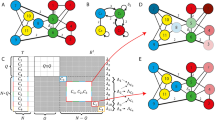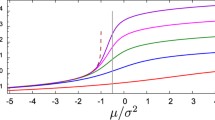Abstract
A discrete theory of synchronization of optic-nerve responses during uniform, steady illumination of the compound eye ofLimulus is described here. The theory is a natural extension of the classical steady-state theory of Hartline and Ratliff (1957). In order to explain the asynchronous response to weak illumination, we find it necessary to take account of observed random fluctuations in the responses of ommatidia illuminated by themselves. Without this noisy component, the computed responses synchronize at very low excitation levels. Once synchronized, the response develops a non-linear dependence on excitation. This non-linearity is a consequence solely of synchronization and is distinct from observed excitation dependences of lateral inhibition between pairs of ommatidia (Barlow and Lange, 1974). Synchronization at the higher excitation levels is also found to reduce or destroy Mach bands which are present in responses to weaker excitations.
Similar content being viewed by others
References
Adolph, A.R.: Thermal sensitivity of lateral inhibition inLimulus eye. J. Gen. Physiol.62, 392–406 (1973)
Barbi, M., Ferdeghini, E.M.: Relevance of the single ommatidium performance in determinning the oscillatory response of theLimulus retina. Biol. Cybern.39, 45–51 (1980)
Barlow, R.B., Jr.: Inhibitory fields in theLimulus lateral eye. J. Gen. Physiol.54, 383–396 (1969)
Barlow, R.B., Jr., Bolanowski, S.J., Jr., Brachman, M.L.: Efferent optic nerve fibers mediate circadian rhythms in theLimudus eye. Science197, 86–89 (1977)
Barlow, R.B., Jr., Fraioli, A.J.: Inhibition in theLimulus lateral eye in situ. J. Gen. Physiol.71, 699–720 (1978)
Barlow, R.B., Jr., Kaplan, E.: Properties of visual cells in the lateral eye ofLimulus in situ: intracellular recordings. J. Gen. Physiol.69, 203–220 (1977)
Barlow, R.B., Jr., Lange, G.D.: A nonlinearity in the inhibitory interactions in the lateral eye ofLimulus. J. Gen. Physiol.63, 579–589 (1974)
Barlow, R.B., Jr., Quarles, D.A., Jr.: Mach bands in the lateral eye ofLimulus: comparison of theory and experiment. J. Gen. Physiol.65, 709–730 (1975)
Brodie, S., Knight, B.W., Ratliff, F.: The spatiotemporal transfer function of theLimulus lateral eye. J. Gen. Physiol.72, 167–202 (1978)
Buller, A.J., Nicholls, J.G., Ström, G.: Spontaneous fluctuations of excitability in the muscle spindle of the frog. J. Physiol. (London)122, 409–418 (1953)
Buller, A.J.: A model illustrating some aspects of muscle spindle physiology. J. Physiol. (London)179, 402–416 (1965)
Coleman, B.D., Maxwell, J.A., Renninger, G.H.: On oscillatory responses of theLimulus retina. Biol. Cybern.37, 125–129 (1980)
Coleman, B.D., Renninger, G.H.: Periodic solutions of a nonlinear functional equation describing neural interactions. Ist. Lomb. Accad. Sci. Lett. Rend. Sci.A109, 91–111 (1975)
Coleman, B.D., Renninger, G.H.: Theory of response of theLimulus retina to periodic excitation. J. Math. Biol.3, 103–119 (1976)
Coleman, B.D., Renninger, G.H.: Theory of spatially synchronized oscillatory responses in the retina ofLimulus. Math. Biosci.38, 123–140 (1978)
Dodge, F.A., Knight, B.W., Toyoda, J.: Voltage noise inLimulus visual cells. Science160, 88–90 (1968)
Eysel, U.T.: Computer simulation of impulse pattern of muscle spindle afferents. Kybernetik8, 171–178 (1971)
Fohlmeister, J.F., Poppele, R.F., Purple, R.L.: Repetitive firing: a quantitive study of feedback in model encoders. J. Gen. Physiol.69, 815–848 (1977)
Fraioli, A.J., Barlow, R.B., Jr.: Research Report LSC-16. Institute for Sensory Research, Syracuse University. Syracuse, N.Y. p. 4 (1972)
Fuortes, M.G.F.: Electrical activity of cells in the eye ofLimulus. Am. J. Opthalmol.46, 210–223 (1958)
Hadeler, K.P., Tomiuk, J.: Periodic solutions of difference-differential equations. Arch. Ration. Mech. Anal.65, 87–95 (1977)
Hartline, H.K., Ratliff, F.: Inhibitory interaction of receptor units in the eye ofLimulus. J. Gen. Physiol.40, 356–376 (1957)
Hartline, H.K., Ratliff, F.: Spatial summation of inhibitory influences in the eye ofLimulus, and the mutual interaction of receptor units. J. Gen. Physiol.41, 1049–1066 (1958)
Kaplan, E., Barlow, R.B., Jr.: Properties of visual cells in the lateral eye ofLimulus in situ: extracellular recordings. J. Gen. Physiol.66, 303–326 (1975)
Kirschfeld, K., Reichardt, W.: Die Verarbeitung Stationärer optischer Nachrichten im Komplexauge vonLimulus. Kybernetik2, 43–61 (1964)
Knight, B.W.: Dynamics of encoding in a population of neurons. J. Gen. Physiol.59, 734–762 (1972)
Knight, B.W.: The relationship between firing rate of single neuron and level of activity in a population of neurons. J. Gen. Physiol.59, 767–778 (1972)
Knight, B.W., Toyoda, J.-I., Dodge, F.A., Jr.: A quantitative description of the dynamics of excitation and inhibition in the eye ofLimulus. J. Gen. Physiol.56, 421–437 (1970)
Lange, D., Hartline, H.K., Ratliff, F.: Inhibitory interaction in the retina. Ann. N.Y. Acad. Sci.128, 955–971 (1966)
MacNichol, E.F.: Molecular structure and functional activity of nerve cells. AIBS Publication No. 1. Am. Inst. Biol. Sci. Wash. D.C., pp. 34–62 (1956)
Maxwell, J.A., Renninger, G.H.: On the theory of synchronization of lateral optic-nerve responses inLimulus. I Uniform excitation of the homogeneous retina. Math. Biosci.15, 117–130 (1980)
Maxwell, J.A., Renninger, G.H.: Theory of oscillations in invertebrate visual systems. Cognition and Brain Theory3, 136–142 (1980)
Purple, R.L.: The integration of excitatory and inhibitory influences in the eccentric cell in the eye ofLimulus. Ph.D. Thesis, The Rockefeller Institute, N.Y. (1964)
Ratliff, F.: Mach Bands: Quantitative studies on neural networks in the retina. San Francisco, CA: Holden-Day 1965
Ratliff, F., Knight, B.W., Dodge, F.A., Jr., Hartline, H.K.: Fourier analysis of dynamics of excitation and inhibition in the eye ofLimulus: amplitude, phase, and distance. Vision Res.14, 1155–1168 (1974)
Renninger, G.H.: Lateral inhibition shapes the oscillatory responses of the horseshoe crab's compound eye. Biol. Cybern. (to be published) (1982)
Renninger, G.H., Barlow, R.B., Jr.: Lateral inhibition excitation and circadian rhythm of theLimulus compound eye. Soc. Neurosci. Abstracts5, 804 (No. 2715) (1979)
Renninger, G.H., Barlow, R.B., Jr., Maxwell, J.A.: Mathematical study of synchronization of responses by lateral inhibition in theLimulus retina. J. Opt. Soc. Am.69, 1433a (1979)
Sirovich, L., Brodie, S.E., Knight, B.W.: Effect of boundaries on the response of a neural network. Biophys. J.28, 423–445 (1979)
Shapley, R.: Effects of lateral inhibition on fluctuations of the impulse rate. J. Gen. Physiol.57, 557–575 (1971)
Stevens, C.F.: A quantitative theory of neural interactions: theoretical and experimental investigations. Ph.D. Thesis, The Rockefeller Institute, N.Y. (1963)
Author information
Authors and Affiliations
Rights and permissions
About this article
Cite this article
Maxwell, J.A., Renninger, G.H. A discrete theory of synchronization of lateral optic-nerve impulses in the horseshoe crab. Biol. Cybern. 46, 41–51 (1982). https://doi.org/10.1007/BF00335350
Received:
Issue Date:
DOI: https://doi.org/10.1007/BF00335350




